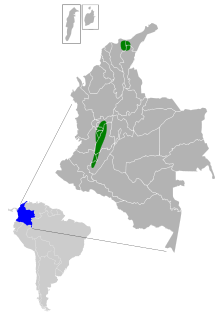Pale-browed hummingbird
| Pale-browed hummingbird | ||||||||||
|---|---|---|---|---|---|---|---|---|---|---|

Pale-browed hummingbird painted by John Gould |
||||||||||
| Systematics | ||||||||||
|
||||||||||
| Scientific name of the genus | ||||||||||
| Anthocephala | ||||||||||
| Cabanis & Heine , 1860 | ||||||||||
| Scientific name of the species | ||||||||||
| Anthocephala floriceps | ||||||||||
| ( Gould , 1854) |
The pale-browed hummingbird ( Anthocephala floriceps ) is a sailing bird in the hummingbird family (Trochilidae). It is endemic to the South American country of Colombia . The stock is on the IUCN as endangered ( Vulnerable classified).
features
The pale-fronted hummingbird reaches a body length of about 8.4 centimeters with the short straight beak about 13 millimeters long. While the front skull is yellowish white in the male, the rear skull is reddish brown. The rest of the top is glossy green with a white patch behind the eye. The underside is grayish yellow. The middle tail feathers are bronze green. The rest looks dark with a white band near the end and yellowish spots. The females are very similar, but have a completely brownish skull.
distribution and habitat
Their natural habitat is moist forests, lighter forest areas and somewhat older secondary forests at altitudes between 600 and 2300 meters.
behavior
The pale-browed hummingbirds are mostly on their own and fly to the flowers of the lower strata . The males gather in small leks and chirp constantly from easily visible branches that are between 2 and 5 meters above the ground. Their breeding season is probably from September to October.
Danger
Only about 15% of the original vegetation of the Sierra Nevada de Santa Marta remains. The greatest threat comes from the cultivation of drugs (marijuana, cocaine). Since the Colombian government wanted to prevent this, it has ordered the spraying of herbicides . Since the 1950s, agriculture (coffee, cattle breeding) increased steadily in these areas, which led to a loss of the original forests, especially in the central Andes.
Subspecies
Two subspecies have been described, which differ in their coloring:
- Anthocephala floriceps floriceps ( Gould , 1854) Nominate form occurs in the Sierra Nevada de Santa Marta at altitudes between 600 and 1700 meters.
- Anthocephala floriceps berlepschi Salvin , 1893 The yellowish spots in the nominate form are white in this subspecies. Subspecies occurs in the valley of the Río Magdalena on the eastern slopes of the central Andes and in the Departamento del Tolima on the Río Toche at altitudes between 1200 and 2300 meters.
Etymology and history of research
John Gould described the hummingbird under the name Trochilus (---?) Floriceps . He had received the type specimen from Jean Linden (1817–1898). After Charles Lucien Jules Laurent Bonaparte (1803-1857) had assigned the hummingbird to the genus Adelomyia , Cabanis and Heine came to the conclusion in 1860 that the species was a genus of its own. The generic name is made up of the Greek words "anthos" ( ancient Greek ἄνθος ) for "flower, blossom" and "kéfalos" ( ancient Greek κεφαλή ) for "head". The specific epithet "floriceps" is derived from the Latin words "flos, floris" for "flower" and "-ceps" for "-headed, -crowned". The subspecies »berlepschi« is dedicated to Count Hans Hermann Carl Ludwig von Berlepsch (1850–1915).
literature
- Steven Leon Hilty , William Leroy Brown : A guide to the birds of Colombia . Princeton University Press, Princeton 1986, ISBN 978-0-691-09250-8 .
- James A. Jobling: A Dictionary of Scientific Bird Names . Oxford University Press, Oxford 1991, ISBN 978-0-19-854634-4 .
- John Gould: Description of five new species of humming birds . In: Proceedings of the Zoological Society of London . tape 21 , no. 251 , 1853, pp. 61-62 ( online [accessed January 18, 2012]).
- Osbert Salvin: Anthocephala berlepschi . In: Bulletin of the British Ornithologists' Club . tape 3 , no. 7 , 1893, pp. VIII ( online [accessed January 18, 2012]).
- Jean Louis Cabanis , Ferdinand Heine junior: Museum Heineanum Directory of the ornithological collection of the Oberamtmann Ferdinand Heine on Gut St. Burchard before Halberstadt . III. Part, containing the shrill birds and the compilation of the genera and species of 1–3, Part. R. Frantz, Halberstadt 1860 ( online [PDF; 16.2 MB ; accessed on January 18, 2012]).
Web links
- Anthocephala floriceps inthe IUCN 2011 Red List of Threatened Species . Listed by: BirdLife International, 2008. Retrieved January 18, 2012.
- BirdLife International: Species Factsheet - Blossomcrown ( Anthocephala floriceps ) . Retrieved January 18, 2012.
- Videos, photos and sound recordings of Blossomcrown (Anthocephala floriceps) in the Internet Bird Collection
- Pale-fronted hummingbird ( Anthocephala floriceps ) at Avibase; Retrieved January 18, 2012.
- Anthocephala floriceps in the Integrated Taxonomic Information System (ITIS). Retrieved January 18, 2012.
- xeno-canto: Sound recordings - Blossomcrown ( Anthocephala floriceps )
